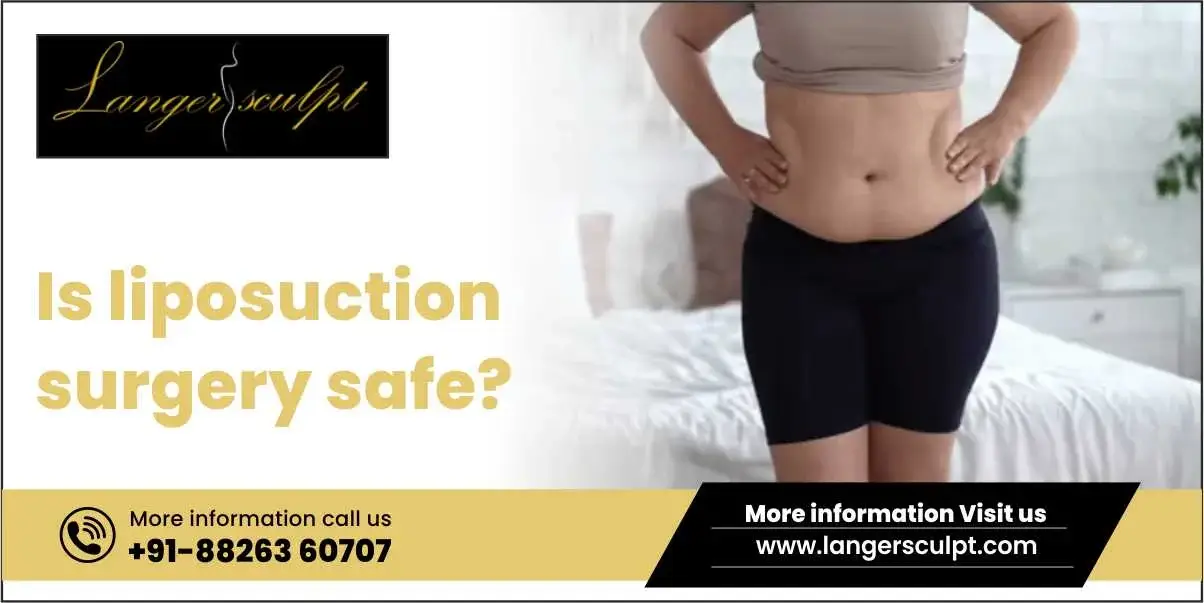

13 May, 2025

In the age of aesthetic enhancement and body contouring, liposuction surgery stands out as one of the most sought-after cosmetic surgical procedures. With the promise of eliminating stubborn fat deposits and reshaping the body, it appeals to individuals striving for their ideal physique. However, despite its popularity, one crucial question remains at the forefront of every potential patient’s mind: Is liposuction surgery safe? The safety of any surgical procedure is a vital concern. Liposuction, while widely practiced and continually advancing in technique, is not without its risks. Langersculpt offers top-tier expertise in liposuction and other cosmetic procedures, ensuring safe and effective outcomes for patients seeking body contouring solutions. Dr. (Col.) Vijay Langer, best plastic surgeon in Delhi, offers a meticulous approach, and his commitment to patient safety makes Langersculpt a trusted choice in South Delhi for those looking to enhance their physique through advanced surgical techniques. This article offers a comprehensive look at the safety profile of liposuction, aiming to educate and empower readers to make informed decisions.
Liposuction is a cosmetic surgery designed to remove localized fat deposits from various parts of the body such as the abdomen, thighs, hips, buttocks, arms, neck, and even the back. It is not a weight-loss method but rather a body contouring procedure that helps refine and improve body proportions for individuals who are close to their ideal weight but struggle with stubborn fat.
Ideal candidates for liposuction are:
It’s important to note that liposuction is not a treatment for obesity, nor is it a replacement for proper diet and exercise.
While liposuction treatment is generally safe when performed by a qualified surgeon, it is still surgery and no surgical procedure is entirely free of risk. According to the American Society of Plastic Surgeons (ASPS), liposuction is among the top five cosmetic surgeries performed annually, with thousands of successful procedures carried out each year.
Some common side effects and temporary symptoms after liposuction include:
Though rare, more serious complications can occur, including:
The safety of liposuction improves significantly when the procedure is performed in a well-equipped medical facility by a board-certified plastic surgeon with extensive experience.
Numerous factors can impact the overall safety and success of a liposuction surgery. Understanding these variables can help prospective patients minimize risk and optimize results.
The most critical factor is the expertise of the plastic surgeon. Choosing a board-certified plastic surgeon ensures that the doctor has undergone rigorous training, adheres to high ethical standards, and is equipped to handle complications.
Patients with underlying medical conditions like heart disease, diabetes, poor circulation, or immune disorders face higher surgical risks. A thorough preoperative assessment, including blood tests and medical evaluations, helps determine if someone is a suitable candidate.
Removing large volumes of fat in one session increases the risk of complications like fluid imbalance, blood clots, and shock. For safety reasons, many surgeons recommend limiting fat removal to about 5 liters per session.
Local anesthesia with sedation carries fewer risks than general anesthesia. However, the choice depends on the treatment area, amount of fat removed, and patient comfort.
Procedures performed in accredited surgical centers or hospitals such as Langersculpt, are significantly safer than those done in unregulated clinics or salons. Accredited centers follow strict protocols for hygiene, equipment maintenance, and emergency response.
Liposuction, while generally safe, is still a surgical procedure that involves certain risks. However, the chances of complications can be drastically reduced when both the surgeon and patient take proactive steps to ensure safety. A collaborative, informed approach not only safeguards health but also enhances overall results and recovery.
The surgeon plays a critical role in minimizing risks through proper planning, technique, and hygiene. Key measures include:
Patients also share responsibility in ensuring a safe procedure and smooth recovery. Important steps include:
When these safety measures are diligently followed, the risk of complications is significantly reduced, making liposuction a safer, more predictable cosmetic procedure.
While liposuction is not a solution for weight loss, liposuction offers several significant benefits that make it an attractive option for those looking to improve their physical appearance and self-confidence.
One of the biggest advantages of liposuction is its ability to target and eliminate stubborn fat deposits that are resistant to diet and exercise. Areas like the abdomen, thighs, arms, hips, neck, and back can be sculpted to achieve a more toned and proportional body shape. This makes liposuction ideal for individuals close to their ideal weight who want to refine specific areas.
Once fat cells are removed through liposuction, they do not return. While future weight gain is still possible if a healthy lifestyle isn’t maintained, the fat distribution typically remains more balanced. As a result, liposuction offers long-term improvements in body contours, especially when combined with proper diet and exercise.
Many people experience a significant boost in self-confidence following liposuction. Wearing clothes becomes more enjoyable, and individuals often feel more comfortable in their own skin. This psychological benefit can positively impact personal, social, and even professional aspects of life.
Although primarily a cosmetic procedure, liposuction can also address certain medical conditions. These include:
With the advancement in liposuction techniques like tumescent, laser-assisted, and ultrasound-assisted liposuction, the procedure has become safer, less invasive, and more precise. Many patients experience faster recovery times and minimal scarring.
Considering liposuction or body sculpting? At Langersculpt, we’re all about helping you feel your best with personalized care and expertise. Our team blends cutting-edge technology with an artistic touch to create safe, natural-looking results. Whether you’re interested in fat removal, skin tightening, or a full aesthetic glow-up, we’ll be with you every step of the way, offering support and skill with a human touch.
When done responsibly, liposuction can offer dramatic improvements in body shape and self-confidence. As with any elective surgery, an informed and cautious approach is the best way to ensure both safety and satisfaction with the results. Choose Langersculpt for a safe, Best Liposuction Surgeon-led liposuction experience that prioritizes your well-being, satisfaction, and confidence.